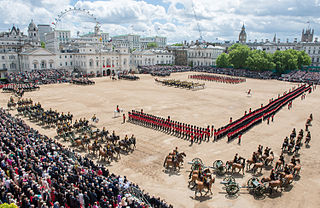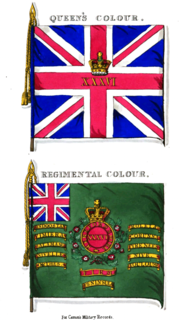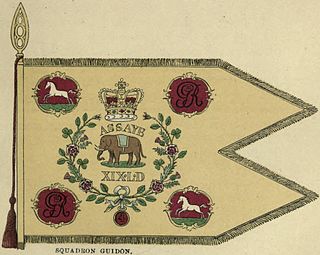Related Research Articles

Trooping the Colour is a ceremony performed by regiments of the British Army. It has been a tradition of British infantry regiments since the 17th century, although its roots go back much earlier. On the battlefield, a regiment's colours, or flags, were used as rallying points. Consequently, regiments would have their ensigns slowly march with their colours between the ranks to enable soldiers to recognise their regiments' colours.

The Royal Regiment of Fusiliers is an infantry regiment of the British Army, part of the Queen's Division. Currently, the regiment has two battalions: the 1st battalion, part of the Regular Army, is an armoured infantry battalion based in Tidworth, Wiltshire, and the 5th battalion, part of the Army Reserve, recruits in the traditional fusilier recruiting areas across England. The Royal Regiment of Fusiliers was largely unaffected by the infantry reforms that were announced in December 2004, but under the Army 2020 reduction in the size of the Army, its second battalion was merged into the first in 2014.

The Princess of Wales's Royal Regiment is the senior English line infantry regiment of the British Army, second in the line infantry order of precedence to the Royal Regiment of Scotland and part of the Queen's Division.

In military organizations, the practice of carrying colours, standards, flags, or guidons, both to act as a rallying point for troops and to mark the location of the commander, is thought to have originated in Ancient Egypt some 5,000 years ago. The Roman Empire also made battle standards a part of their vast armies. It was formalized in the armies of Europe in the High Middle Ages, with standards being emblazoned with the commander's coat of arms.

A battle honour is an award of a right by a government or sovereign to a military unit to emblazon the name of a battle or operation on its flags ("colours"), uniforms or other accessories where ornamentation is possible.

The Regulation Colours are the standard colours used in the armed forces of the countries falling under the Commonwealth of Nations.

The President's Bodyguard (PBG) is an elite household cavalry regiment of the Indian Army. It is senior-most regiment in the order of precedence of the units of the Indian Army. The primary role of the President's Bodyguard is to escort and protect the President of India which is why the regiment is based in the Rashtrapati Bhavan in New Delhi, India. It is equipped as a mounted unit, with horses for ceremonies at the presidential palace and BTR-80 vehicles for use in combat. The personnel of the regiment are also trained as paratroopers and nominally are expected to lead in airborne assaults in the role of pathfinders. The regiment is the successor of the Governor General's Bodyguard of the British Raj.

The 73rd Regiment of Foot was an infantry regiment of the British Army, raised in 1780. Under the Childers Reforms it amalgamated with the 42nd Regiment of Foot to form the Black Watch in 1881.

The Regiment de Meuron was a regiment of infantry originally raised in Switzerland in 1781 for service with the Dutch East India Company (VOC). At the time the French, Spanish, Dutch and other armies employed units of Swiss mercenaries. The regiment was named for its commander, Colonel Charles-Daniel de Meuron, who was born in Neuchâtel in 1738.

The 71st Regiment of Foot was a Highland regiment in the British Army, raised in 1777. Under the Childers Reforms it amalgamated with the 74th (Highland) Regiment of Foot to become the 1st Battalion, Highland Light Infantry in 1881.

The 36th (Herefordshire) Regiment of Foot was an infantry regiment of the British Army, raised in 1701. Under the Childers Reforms it amalgamated with the 29th (Worcestershire) Regiment of Foot to form the Worcestershire Regiment in 1881. Its lineage is continued today by the Mercian Regiment.
The 69th Regiment of Foot was an infantry regiment of the British Army, raised in 1756. Under the Childers Reforms it amalgamated with the 41st (Welch) Regiment of Foot to form the Welch Regiment in 1881.
The 100th Regiment of Foot, or the Loyal Lincolnshire Regiment, was an infantry regiment of the British Army, formed in 1780 and disbanded in 1785. The Loyal Lincolnshire Regiment was reformed in 1794 as the 123rd Regiment of Foot and was again disbanded in 1796.

The 52nd (Oxfordshire) Regiment of Foot was a light infantry regiment of the British Army throughout much of the 18th and 19th centuries. The regiment first saw active service during the American War of Independence, and were posted to India during the Anglo-Mysore Wars. During the Napoleonic Wars, the 52nd were part of the Light Division, and were present at most major battles of the Peninsula campaign, becoming one of the most celebrated regiments, described by Sir William Napier as "a regiment never surpassed in arms since arms were first borne by men". They had the largest British battalion at Waterloo, 1815, where they formed part of the final charge against Napoleon's Imperial Guard. They were also involved in various campaigns in India.

The 19th Light Dragoons was a cavalry regiment of the British Army created in 1781 for service in British India. The regiment served in India until 1806, and in North America during the War of 1812, and was disbanded in Britain in 1821.
The 72nd Punjabis were an infantry regiment of the British Indian Army. They could trace their origins to 1759, when they were raised as the 16th Battalion Coast Sepoys.
The 80th Carnatic Infantry were an infantry regiment of the British Indian Army. They could trace their origins to 1777, when they were raised as the 21st Carnatic Battalion, by enlisting men from the 2nd, the 6th, the 12th and the 15th Carnatic Battalions.
The 98th Regiment of Foot (1780–1785) was a short-lived infantry regiment in the British Army which was raised in England in 1780 as a infantry corps for service in India.
The 101st Regiment of Foot (1780–1785) was a short-lived infantry regiment in the British Army which was raised in Ireland in 1780 as an infantry corps for service in India.
References
- 1 2 Great Britain Public Record Office (1963). Lists and Indexes. London: Kraus Reprint Corps. p. 501.
- ↑ Holden, Major R. (1 February 1895). "The Vicissitudes of Regimental Colours". Royal United Services Institution. Journal. 39 (204): 161. doi:10.1080/03071849509417953. ISSN 0035-9289.